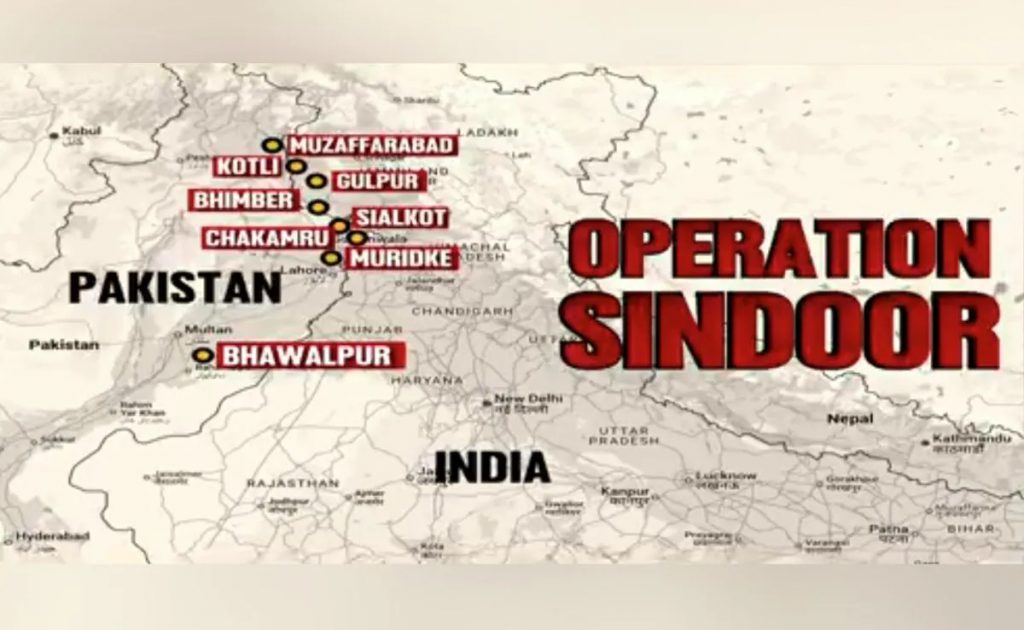Operation Sindoor: India Targets Terror Camps After Pahalgam Attack
India launches Operation Sindoor after Pahalgam attack, targeting nine terror sites backed by Pakistan. Full operation details here.

I. Introduction: India Launches Operation Sindoor
In a swift response to the Pahalgam terror attack, the Indian Armed Forces have launched Operation Sindoor, targeting terror groups backed by Pakistan. This operation marks a significant escalation in India’s counter-terror doctrine, focusing on neutralizing cross-border threats.
Why Is It Called “Operation Sindoor”?
The operation is named “Operation Sindoor” to reflect both sacrifice and symbolism. In Indian culture, sindoor represents protection, sacred duty, and martyrdom. Therefore, the name aligns perfectly with the mission’s purpose and the tribute it pays to the fallen.
II. Background: India-Pakistan Conflict & Terrorism
A. India-Pakistan Conflict History
India and Pakistan share a turbulent history dating back to 1947. Since then, they have engaged in multiple wars and border skirmishes. Consequently, the Line of Control (LoC) remains a sensitive and heavily militarized zone.
B. Rise of Pakistan-Backed Terror Groups
Over the years, terror groups like Jaish-e-Mohammed, Lashkar-e-Taiba, and Hizbul Mujahideen have emerged with support allegedly coming from Pakistan’s ISI. Moreover, these organizations frequently launch attacks in Jammu and Kashmir.
Source: UN Report on Terror Financing
C. India’s Previous Military Responses
In response to past terror attacks, India has undertaken strategic military actions:
- 2016 Surgical Strikes after the Uri attack
- 2019 Balakot Airstrikes following the Pulwama attack
As a result, Operation Sindoor is now seen as a multi-target, proactive escalation in India’s ongoing security policy.

III. Operation Sindoor: Strategy and Execution
A. Objectives of Operation Sindoor
The operation aims to:
- Destroy cross-border terror infrastructure
- Prevent further infiltration
- Retaliate for the Pahalgam attack
- Dismantle operational command nodes
B. Sites Targeted in the Operation
| Site | Location | Target Description |
|---|---|---|
| 1 | Poonch Sector | Training camp destroyed |
| 2 | Kupwara | Terror launchpad eliminated |
| 3 | Rajouri Forest | Weapons storage uncovered |
| 4 | Uri | High-tech comms bunker neutralized |
| 5 | Tangdhar | Sniper nests removed |
| 6 | Gurez | Infiltration trail cut off |
| 7 | Baramulla | Safe house raided |
| 8 | Shopian | Command hub dismantled |
| 9 | Handwara | Explosives factory bombed |
C. Military Strategy
The Indian military employed a multi-dimensional strategy, which included:
- Drone surveillance for identifying key targets
- Precision airstrikes to minimize civilian casualties
- Special Forces teams for rapid incursions
- Electronic warfare to disrupt communications
Furthermore, real-time intelligence sharing between the Army, RAW, and IAF ensured seamless coordination.
D. Global Reaction
International reaction to Operation Sindoor has been mixed:
- United States, France, and Israel expressed support for India’s right to self-defense.
- Germany and the UK, on the other hand, advised restraint.
- China and Turkey, however, criticized the strike and called for immediate de-escalation.
According to BBC News, the United Nations has urged both countries to return to dialogue.
IV. Pakistan’s Response
A. Islamabad’s Official Statement
Pakistan termed the strikes a “flagrant violation of its sovereignty.” Additionally, it accused India of targeting civilians, a claim that India firmly denied.
B. Cross-Border Escalations
In retaliation, Pakistani forces initiated mortar shelling across several LoC sectors. As a result, thousands of civilians in Rajouri, Nowshera, and Keran were forced to evacuate.
C. Comparing Past and Present Responses
Unlike Balakot, which was a single precision strike, Operation Sindoor appears to be multi-phased. It aims not only to send a message but also to degrade the enemy’s ability to strike again.
V. Impact of Operation Sindoor
A. Domestic Implications
Domestically, the operation has received widespread support. Citizens, especially in Kashmir and border states, feel a renewed sense of security. Moreover, political parties across the spectrum have praised the military’s efficiency.
B. Regional Stability
Despite the tactical success, concerns remain about regional stability. If escalations continue, normal life along the border may be further disrupted. However, the Indian Army has taken measures to minimize civilian impact.
C. International Ramifications
As a result of the operation, many international bodies may:
- Reconsider their aid or arms deals with Pakistan
- Apply pressure for concrete action against terror outfits
- Increase support for UN-monitored peacekeeping initiatives
VI. Conclusion
To sum up, Operation Sindoor is not merely a retaliatory strike. It is a clear signal of India’s evolving military doctrine: precision, persistence, and zero tolerance for cross-border terrorism.
While the operation’s success is evident, the long-term implications on Indo-Pak relations and regional peace depend largely on diplomatic efforts.
Pingback: pakistan-india ceasefire violation 2025